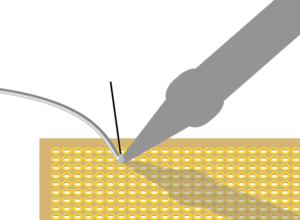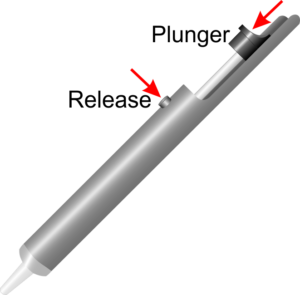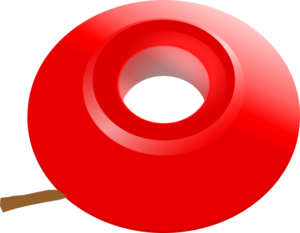When soldering a circuit, it is almost inevitable to make mistakes or make connections where there should not be one. Also when using circuits, components may break and need replacement. That means there is a need to repair soldered connections. In this tutorial we will explain a few of the most common tools and their usage, especially those related to usage of through-hole components.
Use a soldering iron only
The simplest way to desolder is of course using a soldering iron only.
Basic usage:
Heat the solder connection again using a soldering iron. It seems counter intuitive but sometimes adding a little solder helps (by adding flux and for better heat transfer). Use the solder iron to remove solder as much as possible. Sometimes it helps to tap the side of the circuit board on a surface e.g. the table to help remove solder. After that mechanically remove the component, preferably by pulling on the leads using a set of pliers rather then pulling on the component, while continuing to apply heat through the soldering iron.
Advantage:
- No special tools needed.
Disadvantages:
- Hard to remove all the solder.
- Risk of applying excessive heat damaging the circuit board and/or components
- Risk of removing the solder pads from the circuit board.
Use a desoldering pump
A desoldering pump is a manually-operated tool used to remove solder from a printed circuit board. There are two types: the plunger style and bulb style. We will only look at the plunger type pump. This type has a cylinder with a spring-loaded piston which is manually pushed down and locks into place. When triggered by pressing a release button, the piston springs up, creating suction that sucks the solder off from the soldered connection.
Basic usage:
Heat up the solder you want to remove using a soldering iron. But first prepare the desoldering pump using your other hand by pressing down on the plunger until it locks in place. Once the solder is molten, place the tip of the desoldering pump against the solder that you want to remove (while continuing applying heat), then release the plunger by pressing the release button. Repeat these steps to remove any excess solder. Once you remove (most) of the solder, try to remove the component. When ready, clean the inside of the pump by repeatedly pressing down and releasing the plunger and/or removing and cleaning of the tip.
Advantages
- Convenient for getting solder out of holes and in general removing of solder.
- Removed components can be reused because of limited mechanical and heat stress exerted.
Disadvantages
- Although the pumps can have small tips, they are large in general and may be hard to get into very tight spaces.
- Pumps need frequent cleaning of the tip.
Using desoldering braid
Desoldering braid is also known as desoldering wick or solder wick (in Dutch also ‘desoldeer litze’). Desoldering wick is finely braided copper wire coated with flux, usually supplied on a roll.
Basic usage:
The end of a length of braid is placed over the soldered connection(s) of a component being removed. The connection(s) are heated through the braid with a soldering iron until the solder melts and is drawn into the braid through capillary action. The braid is removed while the solder is still molten, its used section cut off and discarded when cooled down. Repeat these steps if necessary. Once you removed (most) of the solder, try to remove the component. Short lengths of cut braid will prevent heat being carried away by the braid instead of heating the solder.
Tip: Use a pair of needle-nose pliers to position and hold down the wick without getting burned. Lipids from the skin degrade the working of the desoldering braid.
Advantages:
- Desoldering braid is relatively cheap and easy to use.
- Desoldering braid works very well for removing solder from flat surfaces.
- Removed components can be reused.
Disadvantages:
- Desoldering braid isn’t reusable, you need start with a clean segment of braid each time you use it.
- It gets hot, so it can be tough to reposition once you’ve started.
- It is also hard to get solder out of pin holes using desoldering braid.
General tips
- If you are trying to remove excess bits of solder, you may want to add more solder to the joint, because the solder will stay liquid for longer when in larger “blobs” and because you add flux in that way, and that makes it easier to remove.
- If you need to remove a header, cut the plastic keeping the pins together using cutting pliers, so you can remove one pin at a time as opposed to all at once.
- Same goes for components with more than a few leads. Cut the leads and remove the remaining pieces one at a time. This will render the component useless but keep the circuit board intact.
- The copper soldering islands on printed circuit boards and perf or experiment boards are vulnerable. Too much force will detach them from the board. If your printed circuit board has so-called vias (electrical connectors between the metal layers in a printed circuit board) also be careful not to damage those.


